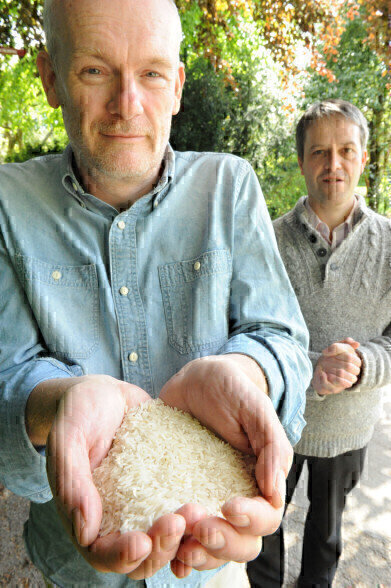-
 Professor Andrew Meharg and Dr Adam Price
Professor Andrew Meharg and Dr Adam Price
News
DNA Sequencing to Create New Rice Variety
Oct 15 2012
University of Aberdeen scientists are using DNA techniques to analyse genes in rice with aims to develop a new variety of grain with greater health benefits. Funded by a £1.2M grant from the Biotechnology and Biological Sciences Research Council (BBSRC), the project involves collaborators from Lancaster, Bangladesh, India and the Philippines.
Professor Andrew Meharg, a biogeochemist at the University of Aberdeen is one of the leads on the four-year project; “Our work is focused on Bangladesh, where rice accounts for 70% of the population’s calorific intake. We plan to sequence the genes of 300 varieties of rice from the country and surrounding Indian states.
What we will be looking for are markers in each of those individual rice types which can be associated with a positive trait we wish to measure.
For example those that can be attributed to providing a greater yield of the crop or higher levels of zinc. One important trait we will focus on is lower levels of grain arsenic. Arsenic, which is a poison to humans, is taken up by the crop from ground water during the growth process and can sometimes occur at high levels in rice.
The study will also test a technique developed by the International Rice Research Institute (IRRI), which aims to reduce the amount of water currently required in the process of rice production.
Dr Adam Price, from the University of Aberdeen’s School of Biological Sciences, explained: “Rice is relied upon as a staple part of the majority of the world’s diet, yet the process involved in growing this crop is accountable for a massive drain on the world’s water resources - a mammoth 2500 litres amount of water is required to produce just 1kg of rice.”
A technique developed by IRRI is being used where the crop is alternatively flooded and then dried out for 10 to 15 days; benefits believed to be aligned with this method are then studied.
“The first of those benefits is the potentially large reduction in water usage and analysis of this will be a main focus for the study. As a positive offshoot, using less water means that there is less opportunity for arsenic to enter the rice grain from the ground water, leading to lower levels of arsenic contamination.
“Initial studies have also shown that the technique enhances yield and increases the levels of nutrients contained in the grains – specifically zinc and iron. This is of particular significance given that increasing these nutrients in our diets is one of the United Nation’s top ten actions that humans can do to reduce suffering,” Dr Price added.
Digital Edition
Lab Asia Dec 2025
December 2025
Chromatography Articles- Cutting-edge sample preparation tools help laboratories to stay ahead of the curveMass Spectrometry & Spectroscopy Articles- Unlocking the complexity of metabolomics: Pushi...
View all digital editions
Events
Jan 21 2026 Tokyo, Japan
Jan 28 2026 Tokyo, Japan
Jan 29 2026 New Delhi, India
Feb 07 2026 Boston, MA, USA
Asia Pharma Expo/Asia Lab Expo
Feb 12 2026 Dhaka, Bangladesh


















